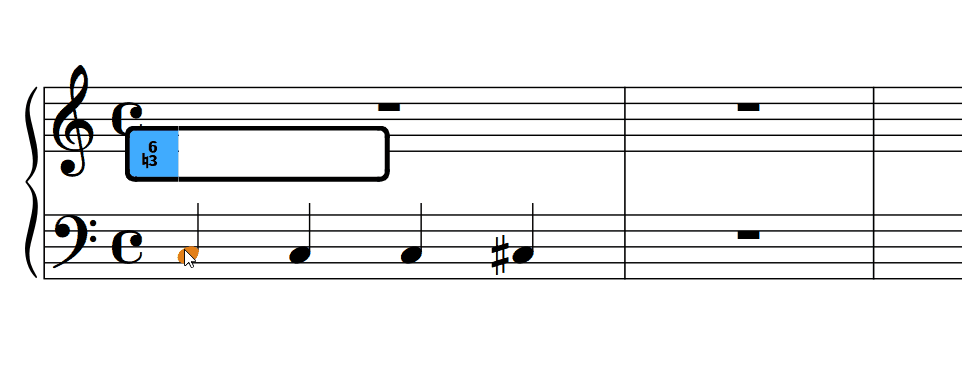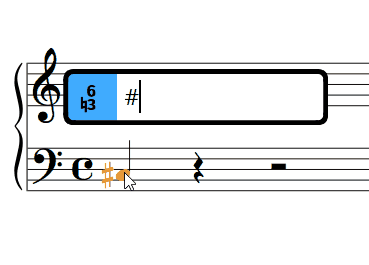“Follow input literally” does very strange things…
See the attached example: the key is G minor (2b). “Follow input literally” is ON.

“Follow input literally” does very strange things…
See the attached example: the key is G minor (2b). “Follow input literally” is ON.

Probably something to do with diminished intervals. Set the Note Input settings for Diminished Intervals to “Allow”.
Thanks, that helped in some, but not in all cases…
However, I thought if “Follow input literally” is ON, then Dorico should really follow my figures…
Anyway, even if I allow diminished intervals, that doesn’t help in all cases: I didn’t have much time to experiment, but I’ve already noticed that Dorico overwrites my “1” with a “8” if the bass note has a sharp or a natural. Also, there are some cases when the “s” doesn’t work, in those cases I had to input “#” instead of “s” to get the sharp.
Can you show an example of the 1 and the s not working? (Full harmonic context.)
I’ve just created an example: C major, “Follow input literally” is ON, diminished intervalls allowed.
As you can see, the in first and second case, Dorico didn’t recognize “s42” and “s6” as valid figures, however “#42” and “#6” are working.
In the last example, Dorico changes the “1” to an “8” if the bass note is raised. The reason for this I think is that in figured bass practice, the “1” above a bass note means a simple unison (or: “tasto solo”), but not for Dorico, who (mis)interprets it as a C natural, which would be of course lower than the bass note itself (C sharp). So it raises the figure by an octave which is not what we normally want…

I think the s is working as intended: for an augmented 4 or 6, you have to use + or #. But it’s worth checking with the team.
The second one does look like a bug.
Sorry but I don’t get the point in the different treatment of “s” and “#”.
“S” is an abbreviation for “sharp” which is “#” in music. So why one is more adequate for normal intervals and the other for the augmented ones?
“+” is not for a sharp symbol but for a slashed figure to my understanding. But again, an updated popover list would be amazing, as there are some “tricks”, which aren’t mentioned in the version history.
I checked with my colleague Richard to make sure of this, and it is what we would expect that entering the figure of “1” would cause Dorico to produce “8” in this circumstance, because in the key of C major, on a bass note of C#, “1” is C natural, and hence it has to be interpreted in terms of the higher octave.
Hi Daniel,
Though I understand this behaviour of Dorico, in baroque/classical music, the figures are relative to the bass notes and not to the key signature: so a “1” upon a C# means simply a unison C#, whatever the key signature is.
Of course, Dorico doesn’t have to follow this practice, but I think that would be what the “Follow input literally” option is for: to give the engraver full freedom to be able to reproduce existing material. I’m working as an engraver, making modern performance materials from original 17-18th century sources (I’m currently working on a big project) so for my work it’s really essential to be able to reproduce exactly what’s in the source.
If you enter “#1” into the Shift+G popover, I think you’ll get the single digit “1” you’re after.
No, if I type “#1”, I get “#1”.

If you have figured bass input set to literal, try <#>1 to get just plain old “1” if your bass note is C#.
Alternatively, if you temporarily change the input options to “Follow Engraving Options,” enter 1 or #1, and the displayed result will also be just “1.” After that the input options can be changed back to literal.
Wow! The “<#>1” is working! Thank you so much!
You’re welcome!
P.S. Turns out, you only need <#>1, no question mark necessary (silly me). I’ve edited my post to reflect that ![]()
I’ve edited it too. ![]() Thanks again!
Thanks again!
Can someone explain why “s” and “#” have different meaning in the popover syntax?
Benwiggy said that the “#” is used for augmented 4 or 6 while “s” is for the other raised intervals.
But actually, Dorico recognizes e.g. “s4b3” upon a C bass note (so an augmented 4 and a lowered 3), while it cannot recognize “s42” (which is the same augmented C-F# interval), so I have to enter “#42” instead. Why?
There is no such distinction between augmented and normal intervals when using the natural symbol for raising an interval: I can type “n42” for exactly the same chord in another key where it would also give an augmented 4 (let’s say in C minor, upon an F bass note = augmented 4 between F and B).
Another example: for a 742 chord with a raised 7 on a G bass note (key signature: C major) I have to enter “#742” (“s742” doesn’t work) - however the G-F# is not an augmented 7…
Thanks in advance!
It looks like there’s a little bug in the interpretation of “s” in the Shift+G popover. If your input consists of “s” followed by one or more numbers, then Dorico will incorrectly attempt to parse that as the duration of a suspension. We’ll fix this if possible in a future update.